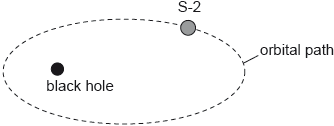| Date | November 2019 | Marks available | 2 | Reference code | 19N.3.HL.TZ0.6 |
| Level | Higher level | Paper | Paper 3 | Time zone | 0 - no time zone |
| Command term | Explain | Question number | 6 | Adapted from | N/A |
Question
A black hole has a Schwarzschild radius R. A probe at a distance of 0.5R from the event horizon of the black hole emits radio waves of frequency that are received by an observer very far from the black hole.
Explain why the frequency of the radio waves detected by the observer is lower than .
The probe emits 20 short pulses of these radio waves every minute, according to a clock in the probe. Calculate the time between pulses as measured by the observer.
Markscheme
ALTERNATIVE 1
as the photons move away from the black hole, they lose energy in the gravitational field ✔
since «the detected frequency is lower than the emitted frequency» ✔
ALTERNATIVE 2
if the observer was accelerating away from the probe, radio waves would undergo Doppler shift towards lower frequency ✔
by the equivalence principle, the gravitational field has the same effect as acceleration ✔
ALTERNATIVE 3
due to gravitational time dilation, time between arrivals of wavefronts is greater for the observer ✔
since , «the detected frequency is lower than the emitted frequency» ✔
NOTE: The question states that received frequency is lower so take care not to award a mark for simply re-stating this, a valid explanation must be given.
time between pulses = 3 s according to the probe ✔
«s» ✔



